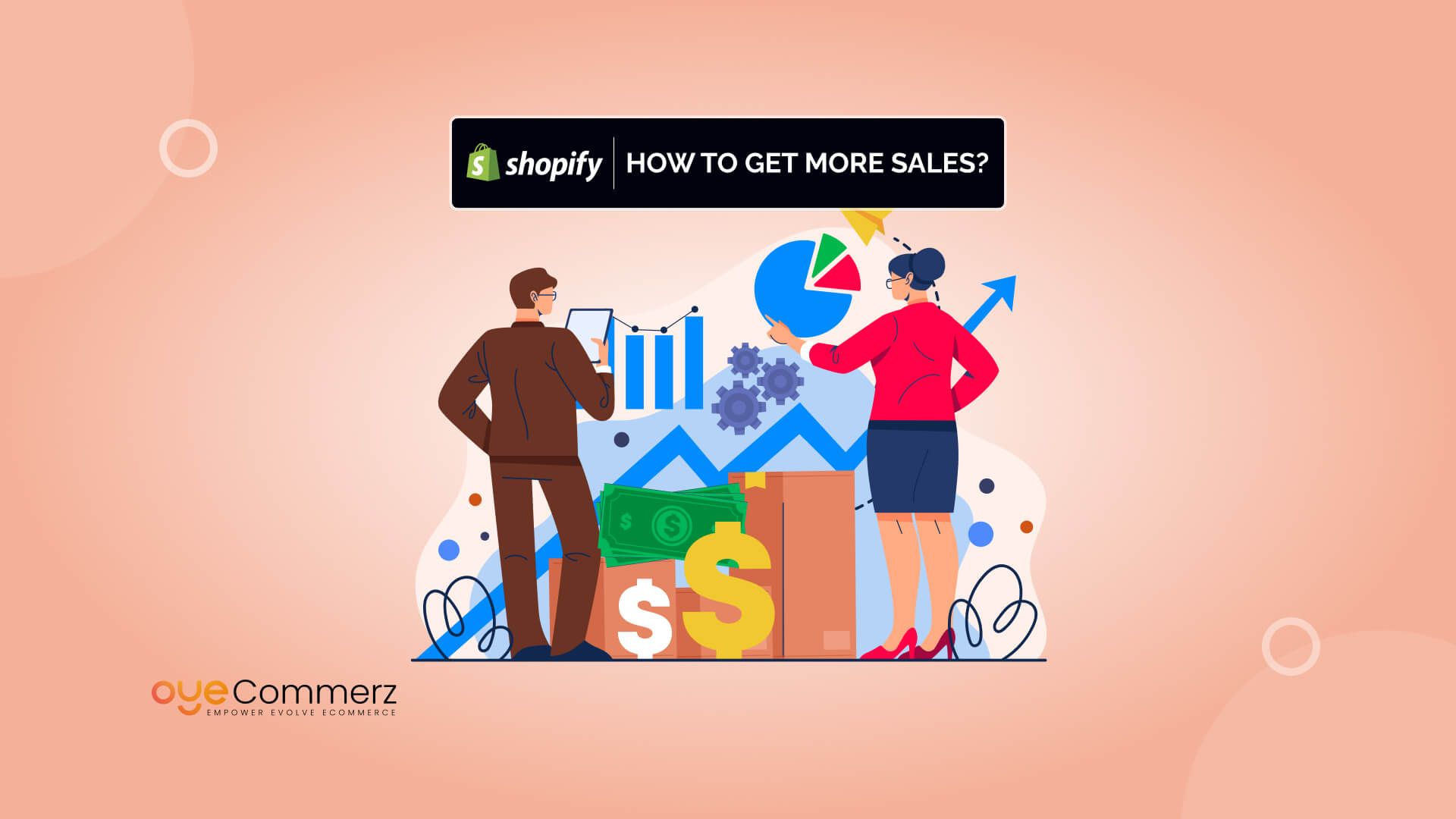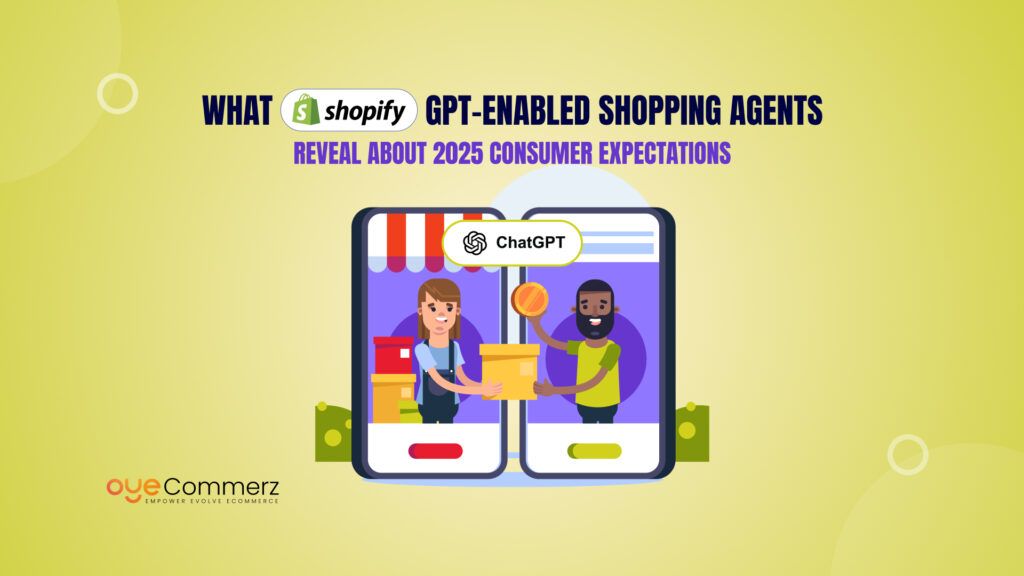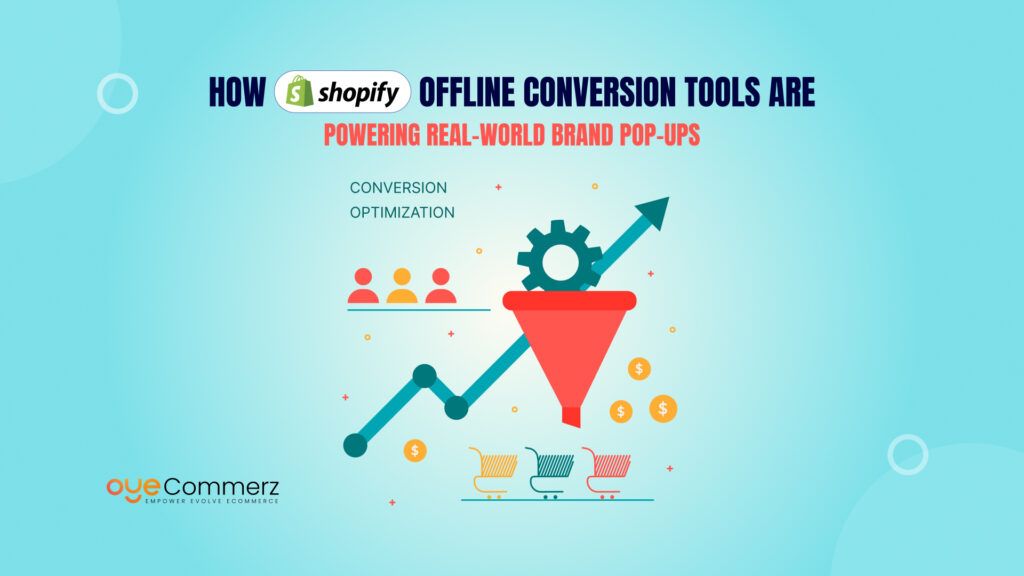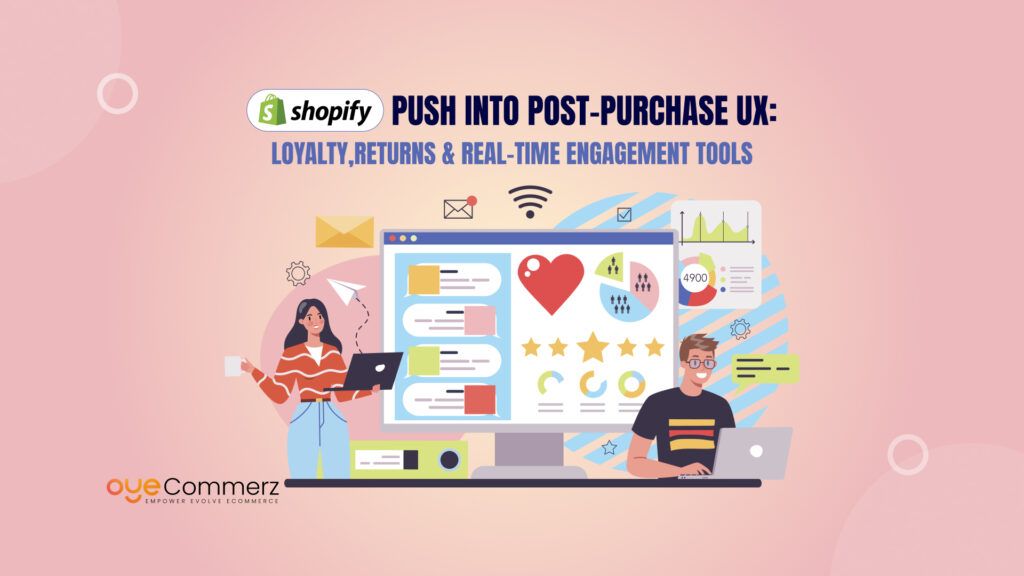Over 4.8 million stores will run on Shopify in 2025. Are you doing enough to stand out?
Shopify makes it easy to launch an online store, but turning traffic into consistent sales on shopify takes strategy. With growing competition, simply listing products isn’t enough.
In this guide, we’ll cover proven tactics and Shopify marketing services that help increase conversions and drive more revenue strategies used by top-performing brands on the platform.
Remember, there’s no single trick to success. It’s about combining the right approaches and refining them over time.
Let’s dive in.
Table of Contents
ToggleHow Sales Work in Shopify
Before diving into sales boosting strategies, it’s important to understand how Shopify handles the sales process from both a technical and business standpoint. Whether you’re new to eCommerce or looking to scale, mastering the basics gives you a serious advantage.
The Shopify Sales Ecosystem
Here’s how the core sales process works on Shopify:
- Product Listings: Add products with images, descriptions, variants (like size or color), and pricing directly in your Shopify dashboard.
- Storefront: Shopify provides a customizable online storefront where customers can browse, search, and view your products.
- Checkout Process: Customers add items to their cart and complete purchases through Shopify’s secure, mobile-optimized checkout system.
- Order Management: Once a sale is completed, it appears in your Shopify admin under the “Orders” tab, where you can process, fulfill, or track it.
- Payment Gateways: Shopify Payments or third-party gateways (like PayPal, Stripe, Apple Pay) handle transactions securely and quickly.
- Sales Tracking: Real-time reports and dashboards give insights into sales performance, customer behavior, and product trends.
Why Understanding This Matters
Knowing how Shopify’s system works helps you make smarter decisions that directly impact your bottom line:
- Optimize Touchpoints: Every part of the sales flow product pages, checkout, and order fulfillment is a chance to improve the customer experience and increase conversions.
- Performance Monitoring: The built-in analytics tools help you see what’s working (or not), so you can double down on winning products and marketing strategies.
- Automated Workflows: Shopify supports automation for tasks like sending abandoned cart emails, confirming orders, and upselling after purchase.
- Scalability: Once you understand and fine-tune your sales flow, it becomes easier to scale your store across product lines, marketing campaigns, and even new markets.
Common Mistakes New Store Owners Make
Even with a powerful platform like Shopify, many beginners fall into the same traps:
- Ignoring abandoned carts
- Poor product organization and unclear navigation
- Overcomplicating the checkout process
- Failing to use analytics for informed decisions
By understanding how Shopify’s sales process works, you’re already one step closer to running a high-converting, profitable store.
How to Get More Sales in Shopify: 6 Proven Strategies
1. Optimize Your Shopify Store for Conversions
Before driving more traffic, make sure your Shopify store is ready to convert visitors into buyers. These three core areas will help you turn interest into action.
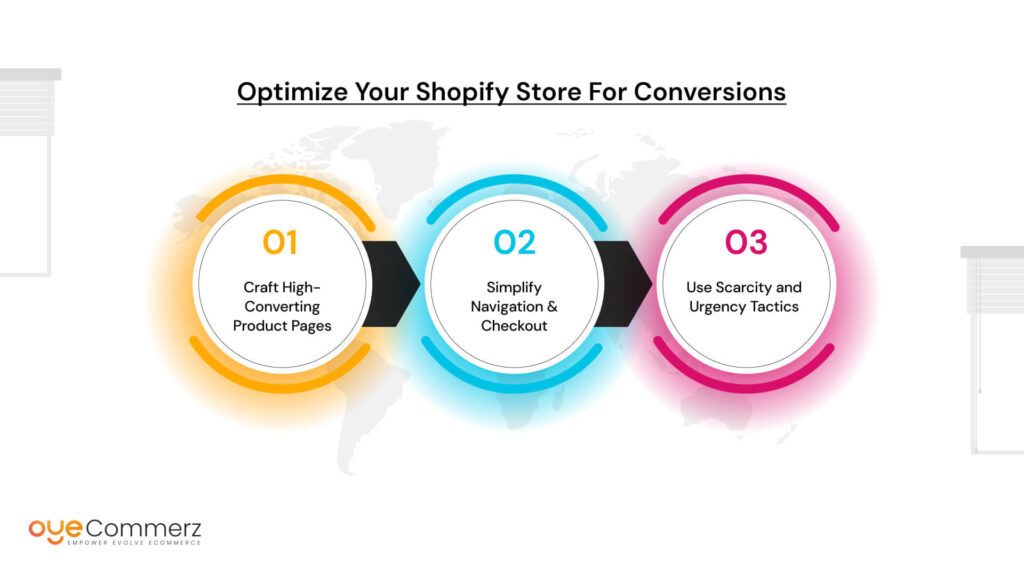
1.1 Craft High-Converting Product Pages
Your product pages are the heart of your store. Here’s how to make them do the heavy lifting:
- High-quality product images: Use multiple angles, zoom features, and lifestyle shots to build trust.
- Compelling product descriptions: Focus on both features and benefits. Show how the product solves a problem or adds value.
- Product videos or GIFs: Short clips can demonstrate usage, texture, or scale better than photos alone.
- Add social proof: Showcase reviews, testimonials, or user-generated content to boost credibility and reduce buyer hesitation.
1.2 Simplify Navigation & Checkout
A smooth experience reduces drop-offs and improves conversion rates.
- Clean layout: Make sure your store is easy to browse, with logical menus and organized collections.
- Mobile-first design: Most shoppers browse on their phones optimize layout, buttons, and speed accordingly.
- Frictionless checkout: Offer guest checkout, one-click buying (like Shop Pay), and multiple payment options (credit cards, PayPal, wallets).
1.3 Use Scarcity and Urgency Tactics
Psychological triggers like scarcity and urgency can significantly boost conversions when used ethically.
- Limited-time offers: Create urgency with flash sales, seasonal promos, or special discounts.
- Countdown timers: Add timers on product or cart pages to emphasize limited availability.
- Low-stock indicators: Let users know when items are almost gone (e.g., “Only 3 left!”).
2. Drive More Targeted Traffic
Once your store is optimized for conversions, the next step is attracting the right audience. Driving qualified traffic people who are already interested in what you sell is key to sustainable growth.
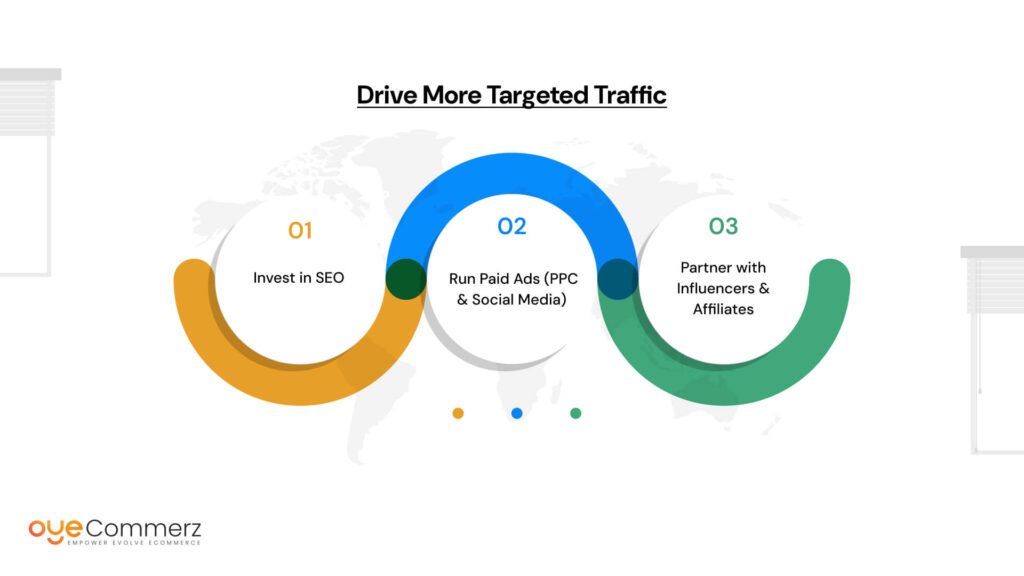
2.1 Invest in SEO
Search Engine Optimization (SEO) helps your store get discovered organically on Google and other search engines.
- Keyword research: Use tools like Ahrefs, Ubersuggest, or Google Keyword Planner to find relevant keywords for your product and category pages.
- On-page SEO: Optimize titles, meta descriptions, headers, alt text, and URLs. Make your content scannable and keyword-rich, but natural.
- Blog strategically: Create content around long-tail keywords, how-to guides, and buyer intent phrases that can bring in top-of-funnel traffic.
2.2 Run Paid Ads (PPC & Social Media)
Paid advertising can bring immediate traffic if done right.
- Facebook & Instagram Ads: Target audiences based on demographics, interests, and behaviors. Great for product discovery and retargeting.
- Google Shopping Campaigns: Perfect for capturing high-intent searchers who are already looking to buy.
- Retargeting ads: Use Facebook Pixel or Google Ads to bring back visitors who didn’t convert the first time.
2.3 Partner with Influencers & Affiliates
Leverage other people’s audiences to grow your own.
- Micro-influencers: Collaborate with smaller influencers in your niche. They often have higher engagement and loyal followers.
- Affiliate programs: Offer commissions to partners who drive sales through unique referral links. Use Shopify apps like Refersion or UpPromote to manage affiliate relationships.
3. Build Trust and Credibility
Trust is a key factor in turning browsers into buyers especially for new or lesser-known Shopify stores. These trust-building tactics help eliminate hesitation and boost conversion rates.
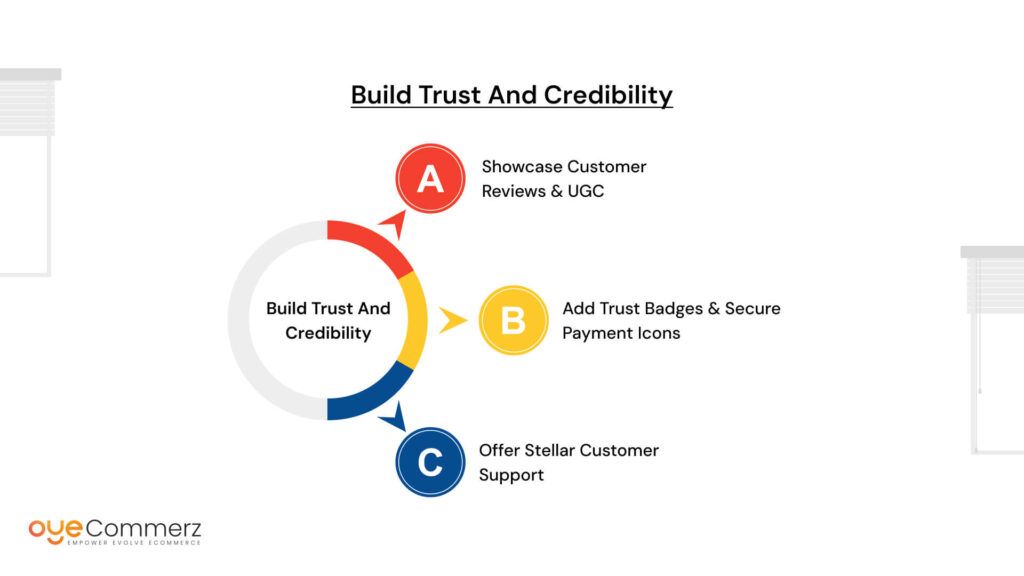
3.1 Showcase Customer Reviews & UGC
Social proof reassures potential buyers that others have had a positive experience.
- Display reviews prominently: Add star ratings and written reviews directly on product pages.
- Use photo/video reviews: Visual content from real customers increases authenticity and helps buyers visualize the product.
- Encourage UGC: Offer discounts or loyalty points in exchange for user-generated content like unboxing videos or Instagram mentions.
3.2 Add Trust Badges & Secure Payment Icons
Small visual cues can make a big difference in building confidence during the buying process.
- SSL and secure checkout: Make sure your site has an SSL certificate (https) and showcase that the checkout is safe.
- Payment logos: Add recognizable icons (Visa, PayPal, Stripe, Apple Pay) to reassure buyers of multiple, secure payment options.
- Guarantees: Clearly display money-back guarantees or hassle-free return policies to reduce buyer risk.
3.3 Offer Stellar Customer Support
Responsive and transparent support shows shoppers you’re reliable and ready to help.
- Live chat or chatbot: Use tools like Tidio, Gorgias, or Shopify Inbox to answer questions in real time.
- Clear return/exchange policies: Make them easy to find and understand, and use plain language.
- Fast response times: A quick reply (especially before a purchase) builds trust and can directly increase conversions.
4. Improve Customer Retention & Lifetime Value
Getting a new customer is great but keeping them coming back is where real profitability lies. Retention strategies help maximize each customer’s lifetime value (LTV) while building long-term brand loyalty.

4.1 Leverage Email Marketing
Email is one of the highest ROI channels for eCommerce when used strategically.
- Abandoned cart emails: Recover lost sales by reminding visitors of the products they left behind.
- Post-purchase follow-ups: Say thank you, request reviews, or recommend complementary products.
- Product recommendation campaigns: Use browsing and purchase behavior to send targeted upsell or cross-sell emails.
4.2 Launch a Loyalty or Rewards Program
Give customers a reason to come back and tell others about your store.
- Points system: Reward actions like purchases, referrals, and social media shares.
- Exclusive offers: Provide discounts or early access to new products for members only.
- Tiered rewards: Encourage continued engagement with VIP levels or bonus perks for top-tier customers.
4.3 Subscription Selling
For stores selling replenishable or recurring products, subscriptions create reliable revenue.
- Turn one-time buyers into repeat customers: Great for consumables like skincare, supplements, or coffee.
- Use Shopify subscription apps: Tools like Recharge, Appstle, or Seal Subscriptions make managing plans seamless.
- Offer bundled subscriptions: Combine popular products into discounted monthly bundles to increase order value.
5. Use Shopify Apps and Integrations to Your Advantage
Shopify’s app ecosystem is one of its biggest strengths. By integrating the right tools, you can automate tasks, personalize the shopping experience, and boost sales with less effort.

5.1 Essential Sales-Boosting Apps
Enhance your store’s functionality with apps built specifically to increase conversions and revenue:
- Email marketing: Tools like Klaviyo or Omnisend help you create automated flows, abandoned cart emails, and personalized product recommendations.
- Review & UGC apps: Platforms like Loox and Yotpo make it easy to collect and display authentic reviews and customer photos, building trust.
- Upsell & cross-sell tools: Use apps like ReConvert or Bold Upsell to recommend add-ons or bundles during and after checkout.
5.2 A/B Testing Tools
Data-driven optimization can have a massive impact on your bottom line.
- Test key elements: Try different product titles, descriptions, images, pricing, and layouts to see what resonates most with your audience.
- Track conversions: Use Shopify-native tools or apps like Google Optimize, Neat A/B Testing, or ConvertFlow to measure performance and refine over time.
6. Analyze Performance and Iterate
Improving sales isn’t a one-time effort, it’s an ongoing process. The most successful Shopify stores consistently analyze data, test changes, and optimize based on what works.
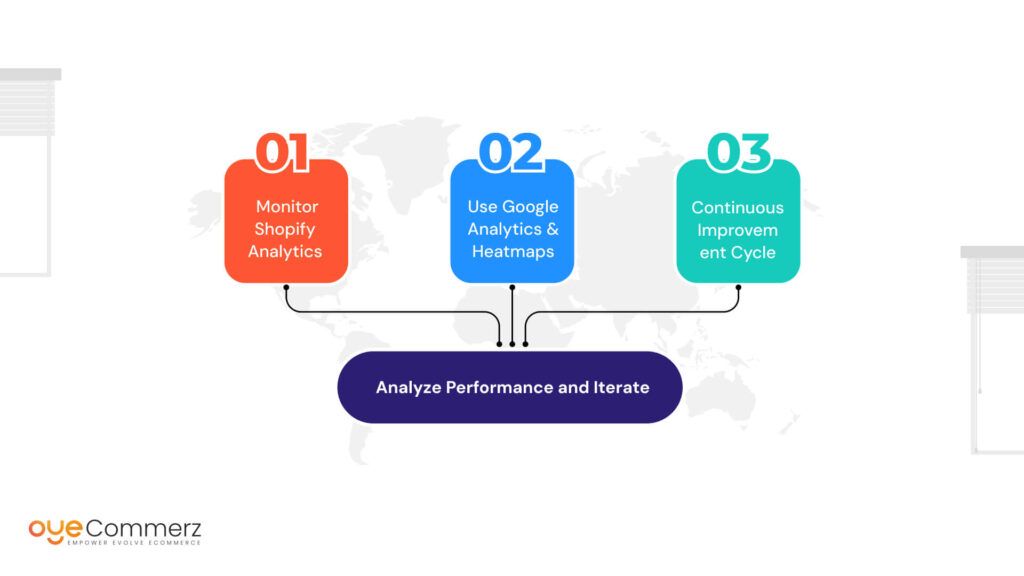
6.1 Monitor Shopify Analytics
Your Shopify dashboard offers powerful insights if you know where to look:
- Track key metrics: Watch your conversion rates, bounce rates, and customer journey through the sales funnel.
- Identify winners: See which products, pages, and traffic sources are driving the most revenue.
6.2 Use Google Analytics & Heatmaps
Go beyond Shopify’s built-in tools with deeper analytics.
- Understand user behavior: Google Analytics shows how visitors interact with your site, where they drop off, and which pages drive engagement.
- Spot bottlenecks: Tools like Hotjar or Crazy Egg offer heatmaps and session recordings to highlight friction points in navigation or checkout.
6.3 Continuous Improvement Cycle
The formula for long-term success is simple but powerful:
- Test → Analyze → Optimize → Repeat
- Don’t rely on guesswork, let data guide your decisions and make incremental changes that lead to measurable growth.
Grow Your Shopify Store with Oyecommerz
Ready to boost your Shopify sales? Oyecommerz offers expert Shopify marketing services designed to drive traffic, increase conversions, and grow your brand. From SEO to email automation, our team helps you scale smarter. Partner with Shopify experts who understand what works. Let’s grow your store together.
Let's Migrate to Shopify today!
Conclusion
Boosting sales on Shopify takes more than just a good-looking store; it requires a combination of proven strategies, consistent effort, and data-driven decisions. From optimizing product pages to running paid ads and leveraging loyalty programs, every tactic plays a role. By working with experienced professionals offering Shopify marketing services, you can accelerate growth and avoid costly mistakes. Don’t rely on guesswork, partner with Shopify experts, test what works, and scale with confidence.
Frequently Asked Questions
To achieve high sales on Shopify, focus on conversion-optimized product pages, fast-loading mobile design, and targeted marketing. Use email automation, upselling apps, and detailed analytics to maximize performance. Working with Shopify marketing experts can also help scale your efforts strategically.
Attract customers by driving targeted traffic using SEO, paid ads, content marketing, and social media promotions. Influencer partnerships and affiliate marketing also boost visibility. A well-designed, trustworthy store with fast shipping and great offers encourages visitors to buy.
Getting sales on Shopify can be challenging at first without proper planning. Many new store owners struggle due to poor traffic, low trust, or ineffective marketing. But with the right tools, strategy, and expert guidance, it becomes much easier to generate consistent sales.
You can make more money on Shopify by increasing order value (using bundles or upsells), running retargeting ads, offering subscriptions, and building customer loyalty. Email marketing and product reviews also play a major role in turning visitors into repeat buyers.
Use platforms like Instagram, Facebook, TikTok, and Pinterest to showcase your products with lifestyle content, reels, and influencer collabs. Paid social ads, UGC (user-generated content), and interactive stories also help drive traffic and build brand trust—leading to more sales.
Some of the best apps include Klaviyo (email marketing), Loox (photo reviews), ReConvert (post-purchase upsells), and Bold Upsell. These tools help automate marketing, increase conversion rates, and boost average order value effectively.
It varies some stores see sales within days, others take weeks or months depending on niche, product demand, and marketing effort. Running ads, optimizing your store, and promoting via social media can significantly shorten the timeline to your first sale.
While DIY is possible, professional Shopify marketing services can save time, reduce costly mistakes, and help you grow faster. Experts provide data-driven strategies, handle campaigns, and optimize your store for better ROI especially if you’re serious about scaling.

